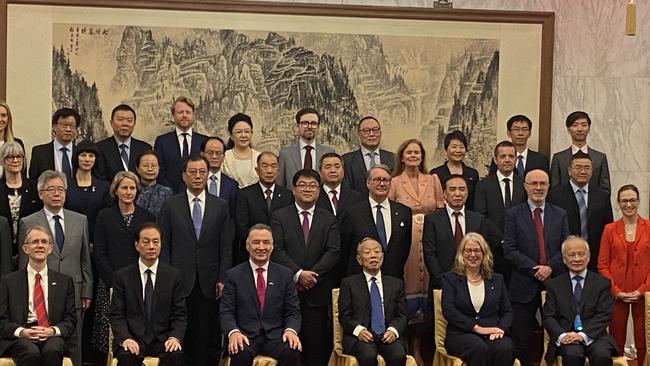
It’s been 18 months since I was last here for a fortnight in the Beijing Winter Olympics bubble. It’s good to be here even if it’s smoggy.
I’m in China’s capital this week thanks to Foreign Minister Penny Wong. At her invitation, I’m one of 18 members on the Australian side of the Australia-China High Level Dialogue. Even with the full backing of the Australian government, the visa process was a classic Chinese bureaucratic nightmare as we waited on the “relevant authorities” in Beijing to approve our trip.
But at least I ended up with a visa unlike my three previous failed efforts this year. It remains the case that Australian journalists can’t get visas to report in China outside of exceptional circumstances, such as this dialogue or visits by ministers.
You’ll be in good company if you have never heard of the Australia-China High Level Dialogue. It’s not the sort of thing that got much attention before our relationship imploded in 2020.
In diplo-speak, it is a “1.5 track meeting”, meaning it has government representatives (in this case, DFAT secretary Jan Adams, our esteemed Ambassador Graham Fletcher and our Ambassador for Climate Change Kristin Tilley) and people who aren’t in government (including some of our top China experts, representatives from industry and the arts, and me and one other journalist).
The dialogue was founded in the Abbott era in 2014, back in the Golden Age of Australian-China relations. The format is closed door and off the record.
I’m told it’s a scripted affair. Back-and-forth dialogue, at what is supposed to be an exchange, has always been minimal, according to past Australian attendees. The Chinese delegates mostly read from prepared statements.
“It’s a bit like reading the China Daily at full volume,” says one veteran attendee.
This is the first time it has been hosted since former Prime Minister John Howard led the last iteration in Sydney in January 2020.
Former Trade Minister Craig Emerson is leading this Australia delegation, while former Foreign Minister Julie Bishop will chair a session of the all-day meeting to impress Australia’s bipartisanship.
The Chinese delegation is being led by Li Zhaoxing, who was China’s foreign minister back when George W. Bush was America’s president. The China entourage also includes some grandees of the Chinese diplomatic corps, two former Chinese Ambassadors to Australia, a retired People’s Liberation Army major general and — demonstrating their role in explaining China’s worldview — a senior editor at the Global Times, along with one of that masthead’s most prolific columnists.
We had a banquet last night in the Diaoyutai State Guesthouse and I won’t be breaking confidences by saying our Chinese hosts were very welcoming as we enjoyed Chef Wang’s 10 courses. We’ll find out today if that tone continues in the closed-door meeting.
China’s party state media has made a notable fuss about the dialogue every since Foreign Minister Wong released a statement about it over the weekend.
“It will provide a good opportunity for both sides to continue to build on the current upward momentum in bilateral ties,” wrote the China Daily on Tuesday in one of the most positive editorials it has published about Australia over the last six years.
This morning, we woke up to find the Global Times dub the event a “momentous event” with international signficance and a “thermometer for China-Australia relations” — although unfortunately the masthead did also mistakenly call the Albanese government the “Albanian government”.
“We hope that the high-level dialogue between China and Australia can achieve results beyond expectations,” the Global Times editorialised.
I will report back after today’s closed-door “thermometer” check.








I’m back in Beijing, writing this on a bus on my way to what the Global Times has dubbed “not just a momentous event between China and Australia, but also a reflection of the East-West relationship as a whole”. Glad I wore a tie.